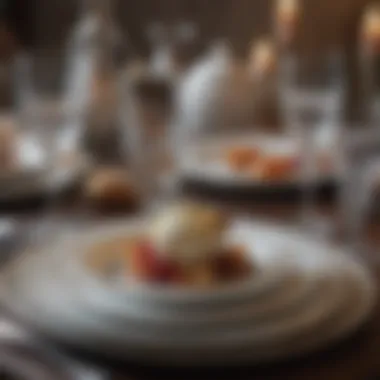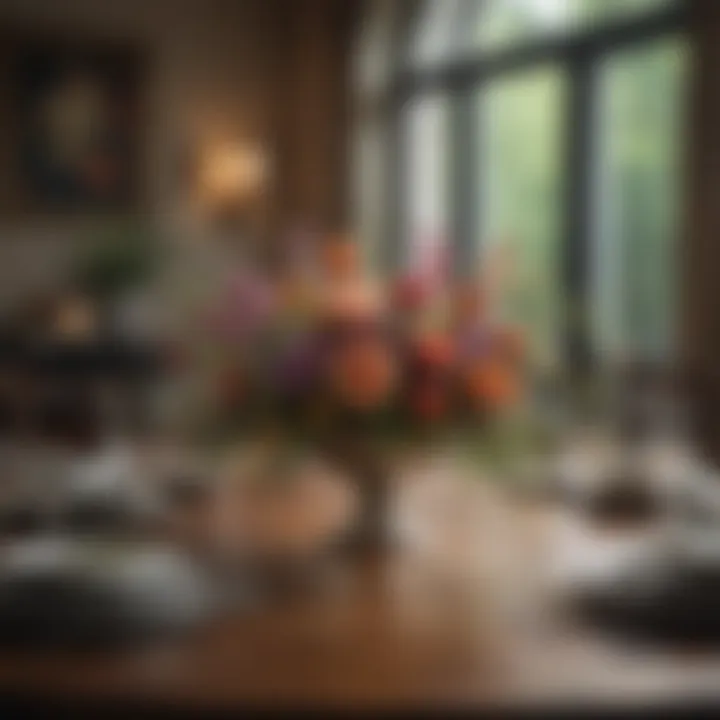Mastering the Art of Elegant Table Setting


Intro
Setting a table is more than just placing dishes, utensils, and glasses on a surface. It involves thoughtfulness, precision, and an understanding of both aesthetic and functional elements. Each piece serves a purpose, not just for eating, but to create an atmosphere, influence conversation, and enhance the overall dining experience. The principles of proper place setting combine art and science, where design meets etiquette.
Architectural Inspiration
In the context of table setting, architectural inspiration plays a key role. This is not just about aesthetics; it reflects the influences of various design styles that can dramatically affect how a dining experience is perceived.
Overview of Design Styles
Different design styles bring forth unique qualities that can influence how a table is set. For example, a minimalist approach focuses on clean lines and simplicity, creating a calm dining atmosphere. In contrast, a vintage style can add warmth and nostalgia, often incorporating intricate patterns and textures.
- Minimalist: Clean, uncluttered settings that highlight simplicity.
- Traditional: Often features classic pieces with rich, dark wood and elaborate patterns.
- Modern: Bold use of shapes and colors, often using contemporary materials.
Understanding these styles can help individuals select the appropriate dinnerware and décor, ensuring the table matches the occasions intended.
Innovative Materials and Techniques
Selectings innovative materials is crucial for achieving a stylish and dynamic table setting. Many designers now focus on sustainability while providing quality and aesthetics. Materials such as bamboo dinnerware or recycled glass can create a unique look while being environmentally friendly.
In terms of techniques, incorporating elements such as layering, placement, and height variations brings depth. For instance, placing taller elements, like candlesticks or floral arrangements, can draw the eye upward, creating an inviting visual flow.
Interior Design Trends
As with any design aspect, trends ebb and flow. Following current interior design trends can enhance the table setting dramatically, aligning it with modern aesthetics.
Color Schemes and Their Psychological Effects
Colors hold significant meaning and can drastically influence moods. For example, warm tones like red and orange can stimulate appetite and conversation, whereas blues and greens tend to create a calm and serene feeling. Choosing the right color palette for the table setting can enhance not only the visual appeal but also the overall dining experience.
- Warm Colors: Stimulating, can enhance social interactions.
- Cool Colors: Calming, often used for more formal or intimate settings.
Space Optimization Tips
Creating a dining area that speaks elegance and comfort involves strategic space optimization. Tables should not feel cramped, and each guest should have ample space to enjoy their meal. To optimize space, consider the following:
- Arrange tables to create movement pathways for serving.
- Use round tables for intimate settings, allowing easy conversation.
- Ensure all items are within easy reach, minimizing overreaching.
"A well-set table is the foundation for a memorable dining experience. Each element, from dinnerware to spacing, plays a part in the narrative of your gathering."
By applying these principles, one can transform any meal into an exceptional dining experience. A thoughtful table setting reflects the host's care and attention, ultimately creating a welcoming atmosphere for all to enjoy.
Understanding the Fundamentals of Table Setting
Creating a well-set table involves more than just placing dishes in order. It requires an understanding of both art and science. Proper table setting can enhance the dining experience significantly, making meals feel special and organized. To initiate discussions on social etiquette or culinary art, one must acknowledge the fundamental elements that constitute a well-done place setting.
Aspects like visual appeal and functionality intermingle in table setup. A thoughtfully arranged table invites diners to indulge, promoting a sense of anticipation before the meal. Moreover, the fundamental rules teach us about balance and proportion in dining settings, elements that contribute both structurally and visually to the overall atmosphere.
Definition of a Proper Place Setting
A proper place setting consists of a precise arrangement of dinnerware, utensils, and glassware. This setup varies depending on the dining occasion, but there are universally accepted guidelines that are followed. The essential components include a dinner plate positioned at the center, forks placed to the left, and knives and spoons aligned to the right. Each item's placement holds specific significance, as it interprets the type of meal to expect.
A basic definition would largely include:
- Dinner Plate: The main dish is served atop this center piece.
- Utensils: Usually, forks on the left and knives and spoons on the right.
- Glassware: Positioned above the knife, indicating the beverage options.
- Napkin: Typically placed either on the plate or beside it, for easy access.
The Importance of Table Setting
The importance of table setting cannot be understated. It serves several purposes. First, it enhances aesthetics, creating a pleasant environment. A visually appealing table can stimulate conversations. Secondly, it sets a mood. A formal setting may indicate a special occasion, while a casual arrangement presents a relaxed atmosphere.
Furthermore, an organized table aids in promoting smooth service flow. When everything has its specific place, it reduces confusion during serving. Guests understand what to expect and how to navigate their dining experience. Proper table setting relates to etiquette, dictating how diners interact with the space and each other. Thus, it is crucial for hosts to recognize its role in cultivating an enjoyable dining experience.


A well-set table not only showcases the meal but also reflects the hosts’ thoughtfulness.
Essential Components of a Place Setting
Understanding the essential components of a place setting equips hosts and diners with the knowledge needed to create a dining experience that is not only functional but also aesthetically pleasing. Each element within a place setting serves a specific purpose, contributing to the overall enjoyment of the meal. The right components can enhance the visual presentation and facilitate seamless dining etiquette. A thoughtful arrangement makes guests feel welcomed and valued, while also signaling the type of meal being served.
Dinner Plates and their Sizes
Dinner plates are the mainstay of any place setting. Their size and design can significantly impact the eating experience. Typical dinner plate sizes range from 10 to 12 inches in diameter. Understanding these variations is key, as different plate sizes may be used for various courses. For instance, a larger plate is appropriate for main dishes, while a smaller plate is often used for appetizers. Choosing the correct size plate ensures that there is adequate space for food without overcrowding, promoting a more enjoyable dining experience.
Utensils: The Forks, Knives, and Spoons
Utensils fulfill practical roles in table settings. From forks to knives to spoons, each serving a unique function at different stages of the dining experience. Proper placement and type of utensils can enhance the overall impression of the table setting.
Placement of Utensils
Proper placement of utensils is crucial. Utensils should be positioned in the order of use, from the outside in. The knife and spoon should be on the right side of the plate, while forks should be placed on the left. This arrangement reflects dining etiquette and helps guests easily locate their utensils as courses are served. A clear layout contributes to smoother dining transitions and minimizes confusion during meals.
Types of Utensils
Different types of utensils cater to different dining needs. Forks are typically used for main courses, while knives are necessary for cutting. Spoons can be for soups or desserts. Notably, using high-quality utensils, such as stainless steel, enhances durability and reflects the care put into the dining setting. Each utensil type has its role, and understanding these roles adds to the appreciation of the dining experience.
Glassware: Types and Usage
Glassware adds a distinct visual appeal to the table setting. Different types of glassware serve specific beverages, such as red wine glasses, white wine glasses, water goblets, and champagne flutes. The choice of glassware impacts not only aesthetics but also the sensory experience of consuming beverages. For example, a wine glass designed for red wine enhances the aromas. Understanding the types of glassware is essential in a properly set table.
Napkins and Their Presentation
Napkins serve a dual purpose; they are both functional and decorative. A well-folded napkin adds to the table's visual appeal. Options include basic folds or elaborate designs based on the dining occasion. Placement often varies; napkins can be set on the plates or to the left of the forks. Choosing high-quality napkins enhances the overall feel of the table setting, providing comfort to the guests.
Table Linens: The Underlying Details
Table linens, including tablecloths and runners, provide an essential base for any place setting. They not only protect the table but also add layers of texture and color. The choice of fabric should reflect the event's formality; for example, silk may suit formal occasions, while cotton can work for casual settings. Thoughtful selection of table linens can elevate the dining experience, creating a cohesive ambiance that complements the meal.
Styles of Table Setting
Understanding the various styles of table setting is crucial for any dining experience. Each style reflects not only the nature of the event but also the preferences of the host. By learning about these styles, one can enhance the overall aesthetic and functionality of the dining arrangement. When hosting an event, choosing the appropriate table setting style matters significantly. A well-executed table setting offers an invitation to guests that communicates care and attention to detail.
Formal Table Setting
Key Features
In a formal table setting, precision and elegance are paramount. The arrangement is characterized by uniformly spaced utensils, neatly folded napkins, and a selection of glassware that may vary in type. Typically, a full set of plates and cutlery is arranged for each course. This careful layout not only enhances the visual appeal but also promotes proper dining etiquette. A formal setting often includes specific details, such as charger plates under the dinner plates, which serve both decorative and functional purposes. This unique feature creates a refined look while protecting the table surface from heat. Despite its elegance, the formal arrangement can feel overwhelming for some, especially if they are unaccustomed to such structure.
Occasions for Formal Settings
Formal table settings are often reserved for special occasions. Events like weddings, formal dinners, and holiday celebrations benefit significantly from this style. A formal setting allows hosts to showcase their taste and create an atmosphere of sophistication. Each occasion comes with expectations regarding formality. This heightened attention to detail can be a confirmed positive, establishing a sense of respect and celebration. However, it can also seem daunting, as there is often significant pressure for perfection.
Casual Table Setting
Key Features
Casual table settings provide a relaxed atmosphere while still maintaining elegance. They often include a simpler arrangement of plates, utensils, and glassware. A key feature is the use of fewer utensils, usually just a fork and a knife, which promotes ease of use and fosters a laid-back dining experience. The versatility of this style makes it popular for everyday meals or informal gatherings. The unique combination of simplicity and warmth, along with various decoration options, allows hosts to express creativity without rigid expectations. Yet, this simplicity can sometimes fall short during special occasions where a more polished look is desired.
Occasions for Casual Settings
Casual settings are suitable for everyday dining, family gatherings, or casual parties. They invite guests to feel more at home, creating an enjoyable atmosphere for conversations. This approach makes it easy to adapt to various themes and preferences. The relaxed nature encourages guests to engage more freely with one another. However, it can risk being perceived as too informal for certain celebrations, which require more structure.
Buffet Style Setting
Key Features
Buffet style settings are distinctive for their self-service arrangement. Guests are encouraged to serve themselves from a selection of dishes displayed on a central table. The key characteristic of this style is its flexibility, enabling a diverse range of food options for guests. This format allows hosts to minimize the pressure of waiting on guests and can accommodate larger gatherings. A unique feature of buffet style is the way it encourages interaction among guests, fostering spontaneous conversations across tables. Nevertheless, the presentation must be enticing, as a poorly arranged buffet can deter guests.


Efficiency in Buffet Settings
The efficiency of buffet settings lies in their design that allows for swift service. Guests can dictate their own pace, gathering food at their convenience. This style is particularly beneficial for larger gatherings or events where formal service may be impractical. The ability to choose from a variety of dishes suits diverse tastes and dietary preferences. An advantage of this approach is the atmosphere it cultivates — a more casual and sociable environment. However, hosts must consider the potential for long lines and the need for additional serving utensils to maintain order and hygiene.
Cultural Influences on Table Settings
Understanding cultural influences on table settings is crucial for grasping the full picture of dining etiquette and aesthetics. Each culture has its own distinct approaches and practices that define how meals are enjoyed, presented, and experienced. This section will explore the significance of these cultural influences by diving into Western dining etiquette, Asian dining traditions, and Middle Eastern table customs.
Western Dining Etiquette
In Western culture, table setting is often associated with formality and specific rules. The arrangement of utensils, plates, and glassware follows structured patterns that reflect hierarchy and elegance. For instance, in a formal setting, the arrangement is usually dictated by a three-course meal. The starter plate is often set on top of the dinner plate. Forks are placed to the left while knives and spoons are positioned to the right, reflecting traditional etiquette.
The use of linen napkins is also significant in Western dining. The commonly accepted practice is to place the napkin on the lap, after being unfolded either on the table or in the hand. Not adhering to this custom might be seen as informal or even disrespectful.
Dining events in Western culture range from casual family dinners to elaborate parties. Each setting varies in complexity, yet maintaining basic etiquette remains important. Failure to observe these customs can lead to misunderstandings or discomfort among guests. Hence, understanding these elements is key to ensuring an enjoyable dining experience.
Asian Dining Traditions
Asian cultures offer a rich variety of dining customs that emphasize communal dining and respect for food. For example, in many East Asian traditions, food is served family-style, where dishes are placed at the center of the table for everyone to share. Chopsticks are the preferred utensils, and their proper use involves careful handling, reflecting respect for the meal.
Presentation plays a vital role in Asian dining. The aesthetics of the table setting often include decorative elements like flowers and intricate dishware. Often, the layout is designed to create a harmonious balance. Additionally, starting a meal with a brief expression of gratitude is common, showing reverence for the food and those who prepared it.
Furthermore, the interaction during meals is significant. Conversation can flow freely as guests share food, emphasizing a sense of community. Each country’s customs differ, but the underlying value of respect and unity remains prevalent across various Asian cultures.
Middle Eastern Table Customs
Middle Eastern table customs are distinguished by their warmth and hospitality. Dining traditions in this region often involve elaborate meals that are shared by all guests. Meals are typically served on a large communal platter, signifying togetherness and abundance.
One notable feature is the tradition of using flatbreads, such as pita. Bread often serves as both an eating utensil and a staple of the meal. Additionally, guests are usually encouraged to eat with their hands, providing a personal touch to dining.
Spices and herbs play an essential role in flavoring dishes, which are often vibrant and aromatic. As meals conclude, it is customary to offer tea or coffee to guests as a sign of hospitality. The presentation of such beverages often features ornate cups and trays, aimed at impressing the guests.
In summary, cultural influences on table settings profoundly shape the dining experience. Understanding these influences fosters a deeper appreciation of various practices and enhances one’s ability to engage in intercultural dining scenarios.
"Cultural influences on table settings are not just about aesthetics; they embody the values and traditions of a society."
Exploring the nuances of these customs is essential for creating a meaningful and respectful dining atmosphere.
Common Mistakes in Table Setting
Creating an inviting and functional dining experience requires attention to detail. However, many individuals often encounter challenges in the art of table setting. Understanding and avoiding common mistakes enhances not only the aesthetics of the table but also the overall dining experience. This section highlights fundamental errors that people make when setting a table. Addressing these can lead to a more harmonious and pleasant atmosphere around the dining area.
Incorrect Utensil Placement
The placement of utensils is one of the most critical aspects of table setting. Incorrect positioning can confuse diners. A common error is arranging forks or spoons in a random order. Typically, utensils are placed in the order of use, from the outside in. For example, the salad fork should be on the outermost left, while the dinner fork is closer to the plate.
Mistakes often arise when cutlery is misaligned with the direction they should be used. For instance, the knife blade should face the plate, and spoons should be to the right. Familiarizing yourself with these placements can significantly improve your table settings.
Ignoring Table Size and Shape
Table dimensions matter immensely. Making assumptions about the amount of space available can lead to overcrowding or underutilization of the dining area. When choosing the dinnerware and decor, consider the shape of the table. Rectangular tables often require different arrangement techniques compared to round tables. Failing to adapt to the shape can create discomfort for diners.
Another common oversight is the height of items on the table. Tall centerpieces can obstruct the view, making conversations difficult. Ensuring that the design corresponds to the space available is fundamental.
Overcomplication of Table Decor
While it may be tempting to go all out with decorations, overcomplicating table decor often detracts from the overall experience. This includes cluttering the table with excessive items or choosing overly elaborate centerpieces. Each element should have a purpose, contributing to an organized and appealing table.
One should remember that minimalistic designs often lead to greater elegance. Neatly folded napkins, a touch of greenery, and appropriately sized serving dishes are generally sufficient. Avoid the temptation to include every decorative piece available, as this can overwhelm guests and hinder functionality.
"Simplicity is the ultimate sophistication in design."


By recognizing and eliminating these errors, diners can upgrade their table setting and enhance their meals. Emphasizing clarity, practicality, and style can transform an ordinary dinner into a memorable event.
The Role of Centerpieces
When discussing proper place settings, one cannot overlook the significance of centerpieces. A centerpiece acts as the focal point of the table, drawing attention and contributing to the overall aesthetic of the dining experience. It helps in setting the mood, guiding the ambiance, and enhancing the visual appeal of the table. A well-chosen centerpiece anchors the setting, establishing a theme or style that resonates throughout the meal.
The role of centerpieces goes beyond mere decoration. They can evoke emotions and spark conversations among diners, bringing a sense of warmth and hospitality to the table. The choice of colors, materials, and design can influence the atmosphere significantly. Whether it is a sleek modern arrangement or a classic floral display, centerpieces can reflect the occasion's formality or casual tone.
Additionally, centerpieces should harmonize with other elements of the table setting. This includes considering the dinnerware, glassware, and linens used. Balance is essential; the centerpiece should complement these elements without overwhelming them. Ultimately, centerpieces contribute to a well-thought-out dining experience, elevating both the appearance and enjoyment of the meal.
Choosing the Right Centerpiece
Choosing the right centerpiece requires thoughtfulness and consideration of several factors. One must take into account the occasion, the number of guests, and the overall theme of the table. A floral arrangement might suit a casual brunch, while a more sophisticated arrangement is preferable for a formal dinner.
It is also essential to consider the size of the table. A large dining table may benefit from a striking arrangement that draws the eye and fills space. Conversely, smaller tables might be better suited for simpler, less intrusive centerpieces. Low-profile designs can encourage conversation without obstructing views across the table, while elevated centerpieces can add height and interest if done carefully.
In addition to the physical characteristics, the materials used in the centerpiece can play a significant role. Natural elements such as flowers, branches, and fruits can bring a sense of freshness and vibrancy. On the other hand, materials like glass or metal can impart a sleek and modern touch. Choosing items that resonate with the dining theme will amplify the table's intended mood.
Height and Scale Considerations
When selecting a centerpiece, height and scale are paramount. The proportions must align with the table size and the overall arrangement. Items that are too tall can obstruct the line of sight across the table, creating barriers instead of inviting interaction.
Balancing Aesthetics and Practicality
Balancing aesthetics and practicality is a critical aspect in achieving the desired effect with centerpieces. A visually stunning arrangement, while appealing, must not hinder movement or access to food items on the table. Visual weight and functionality must coexist to enhance not just how the table looks, but also how effectively it serves its purpose.
A centerpiece that balances beauty with practicality can transform the dining experience. For instance, using a shallow vase filled with low flowers can keep the table open while still providing a decorative touch. This idea exemplifies how to marry form and function successfully. Good examples often derive from seasonal motifs that are easily replaceable and maintain an engaging yet manageable approach for hosts.
Planning for Different Occasions
Planning for different occasions is pivotal in the art of table setting. Each event carries its unique atmosphere, expectations, and purpose. Understanding how to best prepare your dining space enhances not only the visual appeal but also the overall dining experience. A thoughtful table arrangement can set the tone for gatherings, encouraging conversation and enjoyment among guests.
Celebratory Events
Celebratory events such as weddings, anniversaries, and milestones require meticulous attention to detail. The table setting must reflect the special nature of the occasion. For instance, using elegant china and crystal glassware can elevate the atmosphere significantly.
- Themes and Color Schemes: Align your tableware with the event's theme or color palette. This creates a unified look that is visually engaging.
- Centerpieces: Incorporate a striking centerpiece, such as floral arrangements or themed decorations, to draw the eye. Make sure it does not obstruct guests' view across the table.
- Personal Touches: Consider personalized name cards or favors to make guests feel valued and enhance their overall experience.
Intimate Dinners
Intimate dinners focus on creating a comfortable and welcoming environment. The goal here is to foster conversation among a small group of people, often friends or family.
- Table Size and Shape: Choose a table that encourages interaction. A round table is ideal as it enhances communication and creates a cozy feel.
- Soft Lighting: Dimmed lights or candles can set a soothing ambiance, making the dinner feel special without being overly formal.
- Simple Elegance: Use basic but elegant dishware. A simple yet tasteful presentation often impresses more than extravagant decor.
Holiday Gatherings
Holidays bring families and friends together, often leading to large gatherings. The table setting should be festive and accommodating.
- Versatile Serveware: Incorporate platters and bowls that allow for family-style serving. This creates a friendly atmosphere and encourages guests to help themselves.
- Seasonal Decor: Integrate seasonal elements such as autumn leaves for Thanksgiving or ornaments during Christmas, making the table visually aligned with the holiday spirit.
- Buffet Options: For larger gatherings, consider a buffet-style layout to minimize crowding while allowing guests to easily access food.
Investing Thoughtfulness Into Occasions: Creating a tailored table setting for each occasion shows your guests that you care, enhancing their experience and the overall event.
Ultimately, careful planning of your table setting for different occasions reinforces the significance of the gathering, setting a strong foundation for lasting memories.
End: Crafting the Perfect Table Setting
Creating the perfect table setting is a blend of art and science. It requires an understanding of the fundamentals, plus attention to aesthetic details and functionality. A well-set table does more than just display dinnerware; it sets the mood for the meal and contributes to the overall dining experience.
One essential benefit of proper table setting is the enhancement of social interaction among diners. When guests arrive at a beautifully arranged table, they feel welcomed and valued, which encourages engagement and conversation. A thoughtful setup promotes enjoyment and appreciation of the meal, fostering a more memorable experience.
In crafting the perfect table, consider the following elements:
- Intention of the Gathering: Define whether it is a casual lunch or a formal dinner. This will influence your choices.
- Space Utilization: Ensure there is enough space for each guest to dine comfortably. Avoid overcrowding the table with decorations or items that may obstruct movement.
- Color Palette: Choose colors that complement your dinnerware and decor. The right colors can evoke feelings of warmth and elegance.
- Cohesion: All components—from table linens to utensils—should harmonize with each other to create a unified look.
- Functionality: Each part of the setting should serve its purpose without compromising style. For example, ensure utensils are easily accessible.
"A well-set table speaks volumes about the host's attention to detail and appreciation for their guests."
Final Tips for Success
- Practice: Like any skill, practice will refine your table setting technique. Set the table multiple times to understand the impact of different arrangements.
- Adapt: Be willing to adjust your style based on the type of event and the preferences of your guests. Flexibility is key to nailing the perfect setup.
- Stay Updated: Follow latest trends in dining etiquette and decor. Magazines and websites often showcase contemporary ideas that can inspire your settings.
- Feedback: After hosting an event, seek feedback from guests. Understanding their perceptions can help you improve future settings.
- Enjoy the Process: Finally, remember that the goal is to create a pleasant experience. Enjoy the creativity of arranging your table, and your guests will feel your joy in the atmosphere you create.







